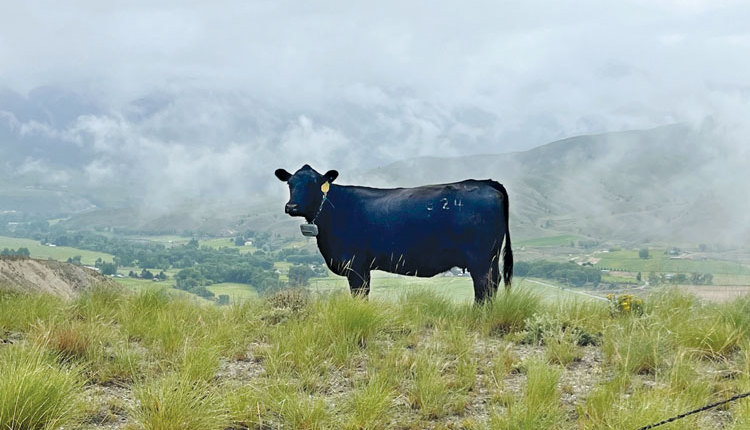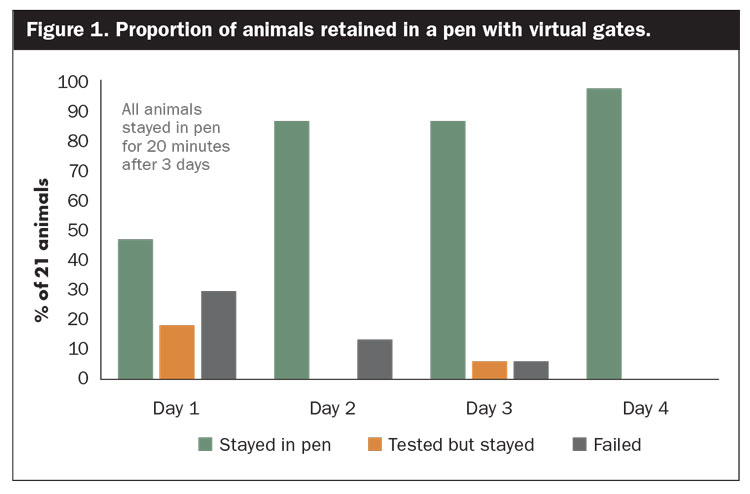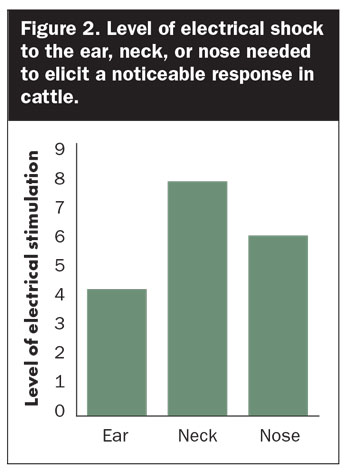The author is a professor at the University of Idaho Rangeland Center in Moscow.

Managing where herds and flocks graze is an age-old challenge of livestock husbandry. For more than 10,000 years, addressing this problem involved intensive herding or barriers made of sticks and stones. In the late 1860s, a major innovation involving a metal wire armed with sharp metal points known as “barbed wire” was introduced. In the 1930s, a wire carrying an electric charge to deter animals was patented and produced the “electric fence.”
Recently, a “virtual fence” with electric pulses delivered to the animals through collars they are wearing has been conjured to replace physical barriers and wires. The idea of fences that can be constructed in a few minutes on a computer interface, requiring no annual maintenance and applied on all types of terrain, has captured interest and skepticism among many ranchers.
With a virtual fence, livestock managers draw pasture boundaries on a computer to produce a location reference map. Livestock wear an electronic band, chain, or collar around their neck and a sound is emitted when the animal approaches a virtual boundary based on their GPS location. An electric shock is delivered through the collar if the animal does not turn away from the boundary. Several companies now offer GPS-based virtual fence systems, which are listed in the accompanying text box.
In the United States, Vence is the most widely available system, with on-ranch testing that started in 2019. Virtual fence has arrived, although there are still a few stones in the road to this becoming a future reality.
An attractive option
Though physical fences are necessary along property or unit boundaries, the ability to easily revise and move a virtual fence will provide unlimited opportunities for cross fencing to facilitate rotational grazing. Fences are also necessary to integrate livestock into crop systems to graze off cover crops, after-harvest residue, and failed crops. In addition, targeted grazing practices for weed control or wildland fuel management to reduce wildfire could be accomplished with virtual fencing.
Building and maintaining fences is costly. Construction of new fence generally ranges from $1,000 to more than $10,000 per mile, depending on the type of fence and terrain. The time and expense to build new and maintain existing fences is a significant enterprise investment and has fueled interest in electronic virtual alternatives.
Fortunately, it is not difficult to get animals to respect virtual fences. Most animals require only a few electric pulses before learning the relevance of the audio warning and quickly turn away to avoid an aversive electric stimulus. In research studies with 21 yearling bulls at the University of Idaho, we found that animals initially tested or disregarded a virtual boundary, but all animals were contained in a pen after just three days of experiencing a virtual gate (see Figure 1).

Protocols can also train animals in groups rather than individually, making the application of virtual fence to herds or flocks more feasible. Additionally, initial studies show little or no evidence of stress to animals while grazing a virtually fenced pasture. Plus, some systems allow ranchers to view animal locations and track animal health attributes such as heart rate and body temperature.
Some failures and challenges
Virtual fence is a new technology that will undoubtedly become more effective and affordable in the years to come; however, results of initial on-the-ground applications revealed several challenges and shortcomings of virtual fence. The greatest source of failure in early tests was the loss of neck collar devices, with several applications on Western ranches reporting devices that fell off or failed on up to 30% of the herd.
Some collars may have been initially fitted and mounted too loosely, allowing the animal to rub or shake the collar off. Certain initial collar designs also failed because screws on the collar came loose and fell off or devices sustained damage from the animal or water. Most of these initial design flaws have been corrected, though loss or failure of collars is a continued concern.
Other challenges voiced by livestock producers include the time required to install and manage a virtual fence system. It takes considerable effort to prepare the devices for deployment and get collars attached appropriately to animals. Some devices also require an occasional battery change, which can require significant time, especially in larger herds. Finally, it was noted in early field applications that finding lost or damaged collars and replacing them on the animal was another considerable time investment.
Animal noncompliance is a persistent concern with virtual fences. Although most animals can be trained to respect virtual fences, a few animals do not respond appropriately to the sound or electrical stimulus. Even among well-trained and responsive animals, a virtual boundary may become less effective as forage availability becomes limited compared to the other side of the virtual fence or when uncollared calves leave the virtual pasture and their mothers cross the boundary to be reunited.
Additionally, the currently available options of virtual fence are not cheap. The cost of virtual fence is highly dependent on the number of communication base stations required, the availability of cellular communication, the subscription fee or purchase price, the cost of batteries, and the expected product lifespan. It is difficult to generalize, but recent costs can vary from $75 to $300 per cow. Though the cost of virtual fence will undoubtedly come down with technological advances, it is currently not a low-cost fencing solution.
Still work to be done
Much is yet to be learned to hone the idea of virtual fence into a highly efficacious system for grazing animals. We need to more fully understand how animals will respond to virtual fence depending on their breed, age, sex, or weight. Developing an effective and ethically appropriate virtual fence system will also require greater knowledge of visual or audio cues that best indicate a virtual boundary. We also need specific details on the contiguity between a warning sound, an aversive electoral stimulus, and the intensity of electrical stimulation needed to hasten animal learning.
Our research being conducted at the University of Idaho and Washington State University has focused on designing a ruggedly simple and reliable device based on low-cost radio communication. We are examining aspects of animal physiology to reduce the level of electrical stimulation required to deter animals from crossing a virtual boundary.

Our research indicates that lower levels of electrical stimulation are required to elicit an animal response when delivered to the ear compared to the neck or nose (see Figure 2). Therefore, we are pursuing all possible ways to lower the weight and energy requirement for animals to respect a virtual boundary. This includes examining training protocols and audio and visual cues to reduce the number of electrical stimulus events needed to effectively contain animals.
Consider also that it may be simpler, and require less energy, to keep animals out of areas rather than containing them in a virtual pasture. Virtual fence is a promising technology to keep livestock away from hay bales or stacks until they are needed as feed. Virtual fence has also been applied to reduce livestock grazing in ecologically important areas such as riparian zones or springs. It can also facilitate restoration and revegetation in forest regeneration sites, and more recently burned areas. Virtual exclusion zones could also reduce human-livestock conflicts by keeping livestock out of areas with high value to humans such as recreation sites and historically important or archaeological sites.
The path toward an effective virtual fence for grazinglands is being paved. As we learn more about animal behavior, we will be better able to select and train animals to adapt and live within virtual pastures. Advances in battery and communication technologies will provide more effective and less expensive systems. Robust virtual fencing technology could, like barbed wire over a century ago, be a catalyst that transforms livestock operations and improves economic and environmental sustainability for ranchers across the globe.
Ongoing research is being conducted by Karen Launchbaugh (grazing behavior), Dev Shrestha (agricultural engineering), Jason Karl (rangeland technology), Katherine Lee, (agricultural economics), and Jim Sprinkle (animal science extension) from the University of Idaho; and by Gordon Murdoch (animal physiology), Tip Hudson (rangeland science extension), and J. Shanon Neibergs (agricultural economics) from Washington State University.
This article appeared in the August/September 2023 issue of Hay & Forage Grower on page 16.
Not a subscriber? Click to get the print magazine.

